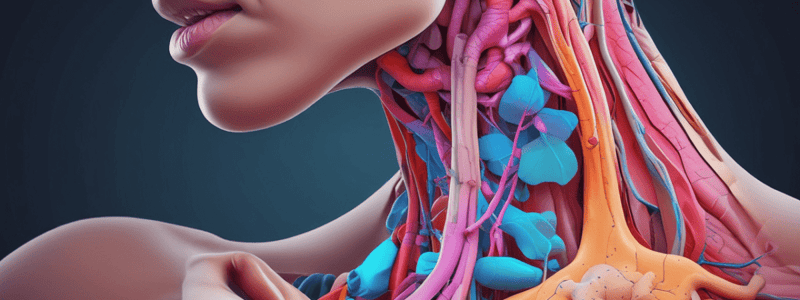Podcast
Questions and Answers
What is the most important muscle to scan in pediatric patients?
What is the most important muscle to scan in pediatric patients?
- Trachea
- Sternocleidomastoid muscle (correct)
- Jugular vein
- Carotid artery
What is the typical appearance of the carotid artery on ultrasound?
What is the typical appearance of the carotid artery on ultrasound?
- Hypoechoic walls and an echo-free center
- Hyperechoic walls and a hyperechoic center
- Hyperechoic walls and an echo-free center (correct)
- Hypoechoic walls and a hypoechoic center
What is the typical appearance of the thyroid gland on transverse ultrasound scans?
What is the typical appearance of the thyroid gland on transverse ultrasound scans?
- Rectangular
- Square
- Triangular (correct)
- Circular
What is the typical size range for a normal thyroid gland?
What is the typical size range for a normal thyroid gland?
Which of the following is a key feature of the jugular vein on ultrasound?
Which of the following is a key feature of the jugular vein on ultrasound?
Which of the following is the most common cause of thyroid enlargement?
Which of the following is the most common cause of thyroid enlargement?
What ultrasound feature is most suggestive of a benign thyroid adenoma?
What ultrasound feature is most suggestive of a benign thyroid adenoma?
Which of the following ultrasound features is most concerning for thyroid malignancy?
Which of the following ultrasound features is most concerning for thyroid malignancy?
What is the most common type of thyroid cyst?
What is the most common type of thyroid cyst?
Which of the following is a key ultrasound feature of autoimmune thyroiditis?
Which of the following is a key ultrasound feature of autoimmune thyroiditis?
What is the characteristic appearance of a simple renal cyst on ultrasound?
What is the characteristic appearance of a simple renal cyst on ultrasound?
Which of the following is a common imaging finding in congenital polycystic kidney disease?
Which of the following is a common imaging finding in congenital polycystic kidney disease?
What is the typical ultrasound appearance of a renal angiomyolipoma?
What is the typical ultrasound appearance of a renal angiomyolipoma?
Which of the following ultrasound features is suggestive of a hydatid cyst?
Which of the following ultrasound features is suggestive of a hydatid cyst?
What is the primary role of ultrasound in evaluating focal renal masses?
What is the primary role of ultrasound in evaluating focal renal masses?
Which of the following ultrasound features is suggestive of a complex renal cyst?
Which of the following ultrasound features is suggestive of a complex renal cyst?
What is the advantage of using ultrasound in evaluating renal lesions?
What is the advantage of using ultrasound in evaluating renal lesions?
Which of the following is a common cause of a solid renal mass?
Which of the following is a common cause of a solid renal mass?
What is the primary role of ultrasound in evaluating renal cysts?
What is the primary role of ultrasound in evaluating renal cysts?
Which of the following ultrasound features is suggestive of a benign renal lesion?
Which of the following ultrasound features is suggestive of a benign renal lesion?
According to TI-RADS, what is the risk of malignancy for a TR5 nodule?
According to TI-RADS, what is the risk of malignancy for a TR5 nodule?
Which of the following compositions would be classified as TI-RADS 1 (benign)?
Which of the following compositions would be classified as TI-RADS 1 (benign)?
Based on the TI-RADS system, which feature is not used to determine the risk level?
Based on the TI-RADS system, which feature is not used to determine the risk level?
Which statement about cystic thyroid nodules is correct?
Which statement about cystic thyroid nodules is correct?
What is the recommended management for a TR3 nodule larger than 2.5 cm?
What is the recommended management for a TR3 nodule larger than 2.5 cm?
Which of the following statements about solid thyroid nodules is incorrect?
Which of the following statements about solid thyroid nodules is incorrect?
According to TI-RADS, which of the following nodules would be classified as benign and require no further evaluation?
According to TI-RADS, which of the following nodules would be classified as benign and require no further evaluation?
Which of the following ultrasound features would contribute to a higher TI-RADS score?
Which of the following ultrasound features would contribute to a higher TI-RADS score?
According to the TI-RADS system, which of the following nodules would require immediate biopsy?
According to the TI-RADS system, which of the following nodules would require immediate biopsy?
Which of the following statements about mixed cystic and solid thyroid nodules is correct?
Which of the following statements about mixed cystic and solid thyroid nodules is correct?
Flashcards are hidden until you start studying




